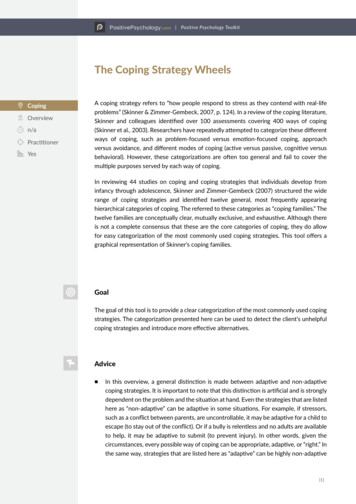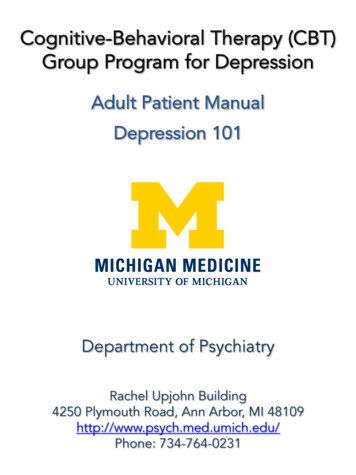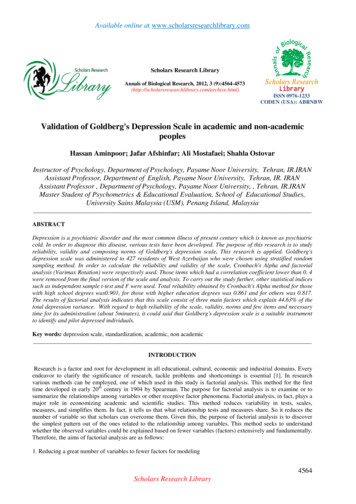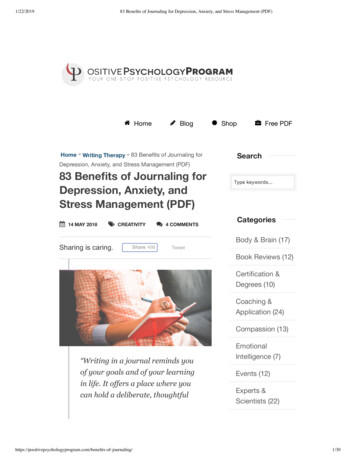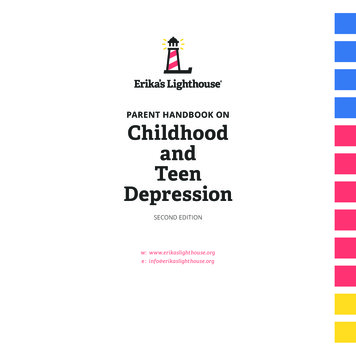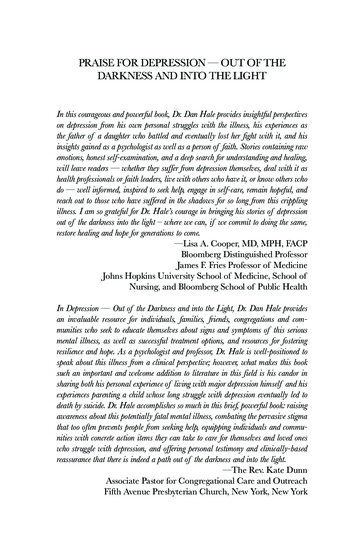
Transcription
COPING WITH DEPRESSIONJudith S. Beck, PhDPresident, Beck Institute for Cognitive Behavior TherapyClinical Associate Professor of Psychology in Psychiatry, University of PennsylvaniaFrancine Broder, PsyDClinical Psychologist, Beck Institute for Cognitive Behavior TherapyB EC K I N S T I T U T E .O RG
RECOGNIZING THESIGNS OF DEPRESSION“I’m down all the time. Nothing helps.”“I can’t get myself to do much work. I’mjust getting by.”“I don’t enjoy things the way I used to.”“Everything is falling apart. It’shopeless.”“There’s something wrong with me. Noone will want to be with me.”“Things are never going to get better.”These are typical thoughts of people who areexperiencing depression. A change in thinkingis a key feature of depression, and thesethoughts reflect a change in the way a personwith depression has come to think aboutthemselves. For example, a devoted parentmay believe they are doing a terrible job. Acompetent employee may view themself as afailure.concentrating and difficulty making decisions,sometimes even simple decisions such as whatto eat. For some, thoughts about ending one’slife show up when depression is moderate tosevere.It is typical for a person with depression toview themself in a negative way, believing theyare helpless, unlovable, and/or worthless.Pessimistic about themself, the world, andthe future, they lose interest in what is goingon around them and describe getting lesssatisfaction from things they previouslyenjoyed.Some people with depression may notexperience the usual sad or dejected feeling.They may instead describe an experience ofgetting no pleasure, they may feel physicaldiscomfort, and/or they may engage inproblematic alcohol or substance use. Whenchildren are observed to have a sustainedchange in functioning at school, this, too, maypoint to depression.The most obvious and typical sign ofdepression is a sad mood. A person withdepression may cry or feel like crying, evenwhen there seems to be nothing to cry about, ormay find it impossible to cry when a sad eventoccurs, even though they feel extremely sad.Behavioral signs of depression may includetrouble sleeping and changes in appetite. Itis also common for people with depressionto describe feeling constantly tired; theymay describe this as feeling “weighed down.”People with depression often report troubleB EC K I N S T I T U T E .O RG
IDENTIFYINGAUTOMATICTHOUGHTSWhat can you do to help yourself? Learninghow to identify what you are thinking is animportant step in reducing depression. Westart by teaching a person to notice whentheir mood has changed or intensified in anegative direction. One might also noticebehaviors associated with negative thinkingsuch as avoidance or engaging in unhelpfulbehaviors (e.g. sleeping too much orovereating). When either mood has changedin a negative direction or a person is engagingin an unhelpful behavior, we suggest askingthe cardinal question of cognitive behaviortherapy:“What was just going through mymind?”This is an important way to help yourselfto identify your own automatic, unhelpfulthoughts. We teach people to pay specialattention to thoughts that get in the way oftaking steps to achieve what is most importantto them. On the first page of this booklet, wegave you some examples of thoughts peoplehave when depression shows up. A personwithout depression may have similar thoughts,but generally dismisses them, understandingthem to be just thoughts, not truths. When aperson with depression has negative thoughts,they often accept them as true, withoutquestion.THINKING ERRORSPeople with depression tend to make consistentthinking errors. Identifying and labelingthinking errors can help you gain perspective.For example, suppose being of service to yourfamily is a strong value of yours. Perhaps youdo what you can to help your grandchildren,but at times you are not available. Youmight have the thought, “I’m a failure as agrandparent.” The most common thinkingerrors are listed below:All-or-nothing thinking: You view asituation in only two categories instead ofon a continuum. Example: “If I’m not a totalsuccess, I’m a failure.”Catastrophizing: You predict the futurenegatively without considering other, morelikely, or just as likely outcomes. Example: “I’llbe so upset, I won’t enjoy myself at all.”Disqualifying or discounting the positive: Youtell yourself that positive experiences, deeds,or qualities don’t count. Example: “I did a goodjob on the project but that doesn’t mean I’mgood at my job; I just got lucky.”Emotional reasoning: You think somethingmust be true because it “feels” true. Example:“I know I do a lot of things OK at work, but Istill feel incompetent.”Labeling: You put a fixed, global label onyourself or others without considering evidencethat might lead to a less extreme conclusion.Example: “I’m a total loser.”Magnification/minimization: When youevaluate yourself, another person, or asituation, you unreasonably magnify thenegative and/or minimize the positive.Example: “Getting a mediocre grade provesB EC K I N S T I T U T E .O RG
how stupid I am.”Mental Filter: You pay a great deal of attentionto one negative detail instead of looking at thewhole picture. Example: Because I got onenegative comment on my evaluation [whichalso contained several excellent comments], itmeans I’m doing a lousy job.”Mind reading: You believe you know whatothers are thinking and fail to consider other,more likely or just as likely possibilities.Example: “They’re thinking I don’t know whatI’m doing.”Overgeneralization: You make a sweepingnegative conclusion that goes far beyond thecurrent situation. Example: “Because I feltuncomfortable at the meeting, I don’t havewhat it takes to work here.”Personalization: You believe others arebehaving negatively because of you, withoutconsidering more reasonable explanations fortheir behavior. Example: “My neighbor didn’tsay hello to me because I did something toupset them.”“Should” and “must” statements: You have aprecise, fixed idea of how you or others shouldbehave. Example: “I shouldn’t make anymistakes.”Tunnel Vision: You only see the negativeaspects of a situation. Example: “The whole daywas terrible.” You don’t consider that you feltbetter when you got dressed, cleaned up thekitchen, went for a walk, and talked to a friendon the phone.RESPONDINGTO AUTOMATICTHOUGHTSMost people with depression believe that thesituations in their lives cause their sadness.While life includes many trying and difficultsituations, our feelings are derived from whatwe think about and how we interpret thesituations we face.“It’s not the situations in our livesthat cause distress, but rather ourinterpretations of those situations.”- Aaron T. Beck, M.D.B EC K I N S T I T U T E .O RG
“Something is wrong.” You might feel anxious.Once you understand what you are thinking,how you feel makes sense.SOCRATIC QUESTIONINGTo expand on the skill of asking yourself“What was just going through my mind?”when you recognize that you’re feeling sador distressed or doing something unhelpful,there are additional, Socratic Questionsyou can ask. These questions will help youevaluate your negative automatic thoughts ina more reasonable, balanced way and developresponses that are more helpful. First askyourself:“What was just going through mymind?”Then ask:In thinking about an event that upset you,consider: the situation;what you were thinking; andhow you felt emotionally.We suggest this as most people are generallyonly aware of how they feel in a situation. Forexample, suppose you texted a close friendseveral hours ago and they didn’t text back. Youmight have the automatic thought, “They don’twant to spend time with me anymore.” Thisthought would likely lead you to feel sad anddejected. Now, imagine you had the thought,1. What makes me think this thought is true?Is there any evidence it might not be true,or not completely true?2. Is there another way of looking at thissituation?3. If the worst happens, what could I do?What’s the best that could happen? What ismost likely to happen?4. What’s the effect of believing this thought?What could happen if I changed mythinking?5. What would I tell my friend [think ofa specific person] if they were in thissituation and had this thought?6. What can I do about this now?By answering these questions with morereasonable, balanced responses, you may findthat you ae experiencing life more realisticallyand beginning to feel a little better.B EC K I N S T I T U T E .O RG
HOW TO GET MOVINGAGAINpush themself to increase their interaction withthem. The person who values being of servicemay continue to help their elderly neighbor,despite the lethargy they are experiencing.One of the most important initial steps forpeople with depression is scheduling activities.We find that many people with depression havewithdrawn from at least some of the activitiesthat previously gave them pleasure, or a senseof achievement, and lifted their mood. Andthey frequently have increased behaviorsthat maintain their depressed mood, such assleeping too much or too little or exercising lessoften (if at all).It can also be helpful to give some thought towhich activities you are doing too much of,and which activities you are doing too little ofor avoiding altogether. Creating and followinga daily schedule with increasing degrees ofactivity can lead to experiencing positiveemotion and, ultimately, decrease depression.People with depression usually believe thatthey won’t enjoy an activity they previouslyenjoyed. They may be anxious that otherswill notice that they are not themselves.Avoidance and inactivity (which result infewer opportunities for pleasure, a sense ofaccomplishment, and connection) lead toexperiencing critical thoughts about being“lazy,” “unlikable,” or “having a bad life,”which in turn maintains the depression. Thenegative thinking and inactivity becomes anegative cycle. Helping you become moreactive and giving yourself credit for your effortsgoes a long way in increasing self-efficacy andimproving your mood.It’s important to give yourself credit for doinganything that was even mildly challenging, oryou didn’t feel like doing, but you did anyway.Create a simply daily list (mental or written) ofpositive things you did that day, deserving ofcredit.Scheduling activities is essential, and keepingaspirations, values, and goals in mind will helpyou select activities that are pleasurable andmeaningful.Once you identify your values, goals, andaspirations, choosing activities in the serviceof these can motivate you to get started.For example, the person who values theirrelationships with family may be motivated toB EC K I N S T I T U T E .O RG
CBT RESOURCESBECK INSTITUTEThe nonprofit Beck Institute for Cognitive Behavior Therapy was established in 1994 by Dr. Aaron T. Beck andDr. Judith S. Beck as a setting for state-of-the-art psychotherapy and professional training in CBT. In our 25year history, Beck Institute has built exceptional in-person and online trainings in CBT, trained thousands ofprofessionals from around the world, and created a global community of CBT practitioners.PSYCHOTHERAPYCognitive behavior therapists can help you identify, evaluate, and modify your unhelpful ideas and behaviorthat lead to negative conclusions about yourself and others. They can also help you figure out ways to moreeffectively manage day-to-day problems. With your effort and their guidance, you can learn skills to reducedepression and help you feel better and stay better. To learn more about clinical services at Beck Institute, call610.664.3020 or email intake@beckinstitute.org.National Suicide Prevention Lifeline (US): 1-800-273-TALK (8255)Crisis Text Line: 741742ONLINE RESOURCES: Visit beckinstitute.org for webinars, video clips and multimedia resources Read the Beck Institute blog (beckinstitute.org/blog) Shop for books, DVDs and more in our CBT Store (beckinstitute.org/store) Sign up for the Beck Institute Newsletter (bit.ly/beckinstitute) Engage with Beck Institute on social UPPORT BECK INSTITUTEBeck Institute is a 501(c)3 nonprofit with the mission of improving lives worldwide through excellence andinnovation in Cognitive Behavior Therapy training, practice, and research. Help us continue our work with agift today!Give now at beckinstitute.org/give-now.B EC K I N S T I T U T E .O RG
The nonprofit Beck Institute for Cognitive Behavior Therapy was established in 1994 by Dr. Aaron T. Beck and Dr. Judith S. Beck as a setting for state-of-the-art psychotherapy and professional training in CBT. In our 25-year history, Beck Institute has built exceptional in-person and onlin


